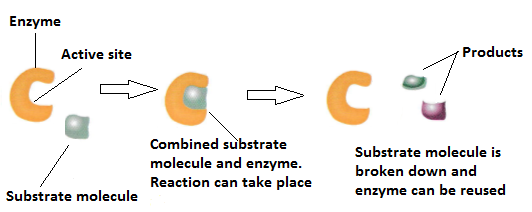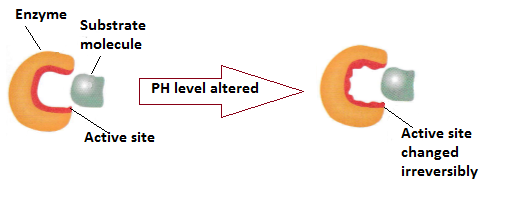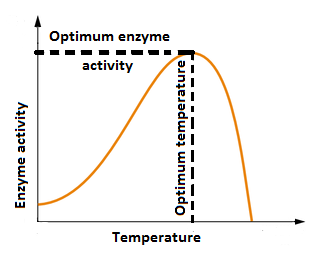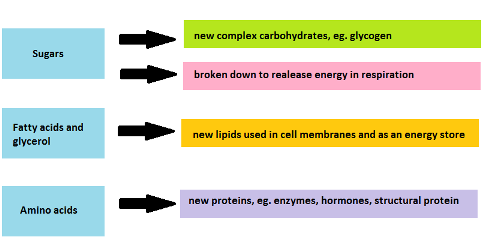Enzymes and Metabolism
Enzymes are large proteins that act as biological catalysts. Enzymes speed up chemical reactions, in living cells these reactions include: photosynthesis, protein synthesis and respiration.
Enzymes
- Enzymes are specific, i.e. one reaction will be catalysed by one enzyme.
- Enzymes can be denatured by high temperatures and or extreme changes in PH level.
- Enzymes have an optimum PH at which they will work, which will vary by activity.
- Enzymes have an optimum temperature at which thy work, for many enzymes this is body temperature (37⁰C)
- Enzymes have and active site, which is formed by the precise folding of the enzyme molecule.
Enzyme Activity
In synthesis reactions enzyme molecules work by colliding with substrate molecules, forcing them to break up and join with others. This is known as lock and key theory.

Excessive heat vibrates the atoms in the protein molecule this will denature the enzyme by putting strain on the bonds and breaking them. High temperatures will change the shape of the active site.

An extreme change in PH will also alter the active site’s shape and prevent it from functioning.

If the temperature is much lower than optimal, an enzyme will continue to work but much more slowly. This is because the low kinetic energy of the substrate and enzyme molecules lowers the number of collisions that can take place. When the molecules do collide the energy is not always sufficient to create a bond.

Enzymes in the digestive system
Large nutrient molecules are broken down into smaller ones by enzymes in the digestive system, this enables the molecules to be absorbed into the blood across the wall of the small intestine.
Enzyme types in the digestive system include carbohydrases, proteases and lipases.
Carbohydrases break down carbohydrates, e.g. amylase which is produced in the small intestine and the mouth.
Starch → maltase
Other carbohydrases break down complex sugars into smaller sugars.
Proteases break down protein, e.g. pepsin, which is produced in the stomach.
Protein → peptides →amino acids
Other enzymes in the small intestine complete protein breakdown with the production of amino acids.
Lipases are produced in the small intestine and breakdown lipids (fats).
Lipid →fatty acids → glycerol
Bile
Bile is produced in the liver and is a digestive chemical. Bile is stored in the gall bladder.
- Bile’s PH is alkaline which neutralises hydrochloric acid that has been produced in the stomach.
- Bile emulsifies fat, breaking it into droplets with a large surface area.
- Bile’s action enables lipase to break down fat more efficiently.
The diagram below shows how food is digested

Calorimetry
The amount of energy contained in a substrate (food) can be measured using calorimetry.
Food is placed in a calorimeter and burned in pure oxygen. The energy released heats up the surrounding water and the temperature rise is measured.
The formula to calculate the energy released per gram is below:
Energy (J) = mass of water heated (g) x 4.2 x temperature rise (⁰C)
